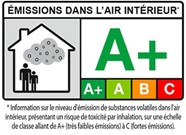
Use and maintenance
Ecology and Environmental protection
-
Ceramics are safe for health
-
Unlimited durability
-
Excellent thermal properties
-
Low maintenance
Ceramic tiles do not release any chemicals or fumes, are non-toxic, and pose no health risks.

-
In the context of the Life Cycle Assessment (LCA), the lifetime of ceramic tiling is officially set at 50 years.
-
The lifetime of replacement materials is not clearly stated, depending on how they are used and maintained.
| FLOOR TYPE |
LIFETIME (years) |
| Ceramic floor tiles | 50 |
| Rubber flooring | ca. 30 |
| Vinyl flooring | 10 - 20 |
| Household carpets | 15 - 20 |
| Commercial carpets | 12 - 15 |


- The service life of ceramic tiles is practically unlimited.
- What are the main benefits of ceramic tiles, compared to substitute materials?
- Tiles are more durable, compared to vinyls, laminates. They are not susceptible to scratches when handling furniture or from pets or children's toys.
- Tiles do not tarnish during operation.
- Tiles do not fade from the sun.
- Ceramic tiles do not mind water, moisture, steam, or temperature changes, they are both mechanically and chemically resistant.
- The tiles are easy to maintain and suitable for allergy sufferers as well.
- Tiles have excellent thermal conductivity, which is important for underfloor heating - 1 W/mK.
- Due to the higher thermal conductivity of ceramics, underfloor heating has a lower energy consumption, compared to vinyl.
- No hazardous chemicals are released from ceramic tiling materials during a fire. Ceramics are fire resistant according to EN 14 411 (reaction to fire).
- If a property is sold, ceramic flooring is valued higher than vinyl (up to 20% difference).
- Ceramics have at least twice the lifetime of vinyl. Including necessary repairs during operation, the ceramics will be cheaper over a 30-50 year period.
- Tiles do not release chemicals.
- The products are disposed of by processing them into recycled material, reusing them for paving, or disposing of them in a landfill. In the case of recycled production, the recycling lines crush and sort the construction material into fractions. The recycled material has the same use as gravel, and its price is one third the price.
- If tiles are disposed of in a landfill, they are not hazardous waste.
- Ceramic tiles are a renewable source.

- Ceramics consider the environment and our health.
- Ceramics are plastic-free and completely recyclable.
- Ceramics are hygienic and hypoallergenic.
- Ceramics do not burn.
- Ceramics do not change their shape, are frost-proof and resist even the most aggressive chemical cleaners.
On the packaging of our products, you can find a label expressing the quality of the indoor environment with regard to the level of emissions emitted by ceramic wall and floor tiles.
The A+ rating is the best rating in this category.

RAKO products are regularly tested for hygienic safety, both for contact with drinking water and food. Ceramic tiles do not support the formation of bacteria and mould.
The service life of ceramic tiles is practically unlimited.


- All the types of RAKO tiles have excellent thermal properties (conductivity and heat accumulation).
- They are the ideal floor covering for underfloor heating.
- Comparison of the thermal conductivity (thermal conductivity coefficient) and ability to accumulate and radiate heat (thermal emissions) of various floor coverings.
The coefficient of thermal expansion of wall and floor tiles is very low. Over the distance of 6 m at a temperature difference of 50 °C, the ceramic material expands by 2.4 mm. For example, concrete will change its length by about twice this value. Therefore, we make expansion joints that are able to absorb such stresses in the substrate.
Comparison of the thermal expansion coefficient of various materials:
| MATERIAL |
LONGITUDINAL THERMAL EXPANSION COEFFICIENT α (10-6·K-1) |
| Ceramics | 4 - 8 |
| Cement screed / concrete | 10 - 12 |
| PVC / Vinyl | 39 - 50 |
| Steel | 12 - 13 |
| Aluminium | 22 - 28 |

- Underfloor heating achieves an almost ideal temperature distribution in the room.
- Thermal comfort is achieved even at a lower air temperature in the heated room.
- Underfloor heating features lower heat losses and generates energy savings.
- Whereas with stove or radiator heating, the difference in air temperature between the floor and ceiling is up to 8 °C, with underfloor heating the indoor air temperature is almost constant.
- Thermal comfort is achieved even at a lower air temperature in the heated room. Therefore, underfloor heating features lower heat losses and generates energy savings. Ceramic tiles feature a favourable thermal conductivity with an excellent ability to store and radiate heat, unlike PVC and vinyl floors.


- Ceramic tiles require only water and detergent/cleaner for maintenance.
Over the entire lifetime of ceramic tiles, no more than 0.3 ml of detergent and 0.002 l of water are needed to clean 1 m2 of ceramic floor tiles once a week, and ceramic wall tiles once every 3 months.
RAKO SYSTEM = special products with high efficiency for the post-building and regular maintenance of ceramic tiles.








